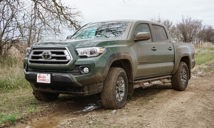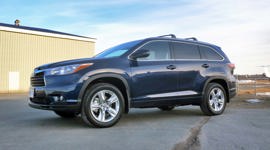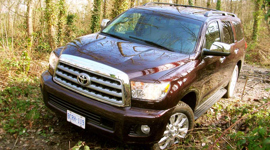History/Description
Toyota’s Canadian-built Matrix was built to answer the call of shoppers after fuel efficiency, safety, and the ability to adapt readily to any trip or task, and a generous space-to-price ratio, all wrapped up in a sporty-looking, easy-to-drive package. Offered in numerous configurations, with various option packages and backed by a wide range of lifestyle-specific accessories, Matrix can be tailored easily to any need or budget. Canadians caught onto this, and bought the flexible five-door model in large volumes.
Feature content included steering wheel audio controls, tilt steering, MP3 audio capability, and a full suite of safety systems. Leather-wrapped accents, Bluetooth, a sunroof, satellite radio and premium audio systems could all be specified, too. Newer models, from 2013 and on, got improved interiors and connectivity features as standard on all models. From 2011 and on, Toyota added their Star Safety System as standard on all models as well, fitting Vehicle Stability Control (VSC), Traction Control (TRAC), an Anti-lock Brake System (ABS), Electronic Brake Force Distribution (EBD) and Brake Assist (BA) for more sure-footed handling and stopping.
Engines/Trim
Look for a 1.8L four-cylinder engine on most models with horsepower in the 130 range, and a 2.4L unit on selected models, with around 160. All-wheel drive was available on select models, and manual or automatic transmissions could be fitted, depending on the model in question.
What Owners Like
Owners typically rave about the on-board space, sporty looks, good fuel mileage, and overall blend of performance, efficiency and utility. The words “perfect size” come up fairly frequently, too. A lengthy list of standard safety systems and generous headroom appealed strongly to some shoppers, too.
What Owners Dislike
Common gripes include larger-than-expected blind-spots, fussy iPod integration, and not quite enough standard power output for hilly terrain, especially with the automatic.
Check out some owner reviews.
The Test Drive
The boss makes me fill a used car feature to about 1,000 words, which is a touch tricky when dealing with the Toyota Matrix, since it’s based on the Toyota Corolla, which is one of the most reliable used-car buys on the road.
So, I could start with a poem, or something.
Ahem. “There once was a man from Nantucket…”
But seriously, Matrix looks solid, with mostly minor and easy-to-diagnose issues reported, though it’s still a car made of parts and components that will eventually break down and wear out, so a pre-purchase check up is still advised. Most of that check up can be done on your test-drive.
First up, some owners have reported faster-than-expected wear of consumable parts, like tires and brakes. Though wear of these parts is largely a function of driving habits and locale, shoppers are advised to ensure both are still in good condition ahead of their purchase, and that the seller isn’t trying to pass off a repair.
Other owners have reported issues with premature wear of CV Joint Boots, which keep nasty road stuff out of the Constant Velocity joint at the end of the front driveshaft. This issue might be more common on lowered models, but isn’t a huge deal to fix. Ask a mechanic to check the CV Joint Boots on the model you’re considering if you aren’t sure how.
Less-than-ideal durability from interior and exterior finishes is also noted by some owners. Interior plastics are said to scratch easily, so if the cabin of the Matrix you’re considering looks more beat up than its age suggests it should, call it into pricing negotiations. Other owners complain of the thin, less-than-durable eco paint used on the Matrix, and how it’s easily damaged, chipped and scratched.
In 2009 models, some owners reported oil consumption in units with the 2.4L engine, which is said to be caused by a block and / or piston ring defect. Some dealers have replaced piston rings and even engine blocks as a solution, under warranty. Though this issue wasn’t rampant, those considering a 2009 Matrix with the larger engine are advised to talk to a Toyota mechanic before agreeing to purchase, or to opt for a 2010 or newer model, which doesn’t seem to suffer from the oil consumption problem. Remember, checking for proper oil level and condition is a good idea in any used ride.
On units with the manual transmission, occasional difficulty shifting to reverse is likely caused by the design of the transmission itself, with many owners accepting the fact and shifting to another gear, and trying reverse again, as a solution.
Confirm proper operation of all window switches, as some owners say they’re said to become sticky and possibly seize over time. Other nitpicky-gripes include interior squeaks and rattles, and a reduction in air conditioner performance that can usually be fixed by cleaning dead leaves and insect corpses out the condenser.
Finally, avoid a used model that’s been modified heavily. Typically, intake and exhaust modifications are safe provided that the quality of the parts and installation are sound. Modifications to the engine management system, suspension, brakes and others could adversely affect durability, warranty coverage and safety. Stick to stock where possible.
Further, if the service history of the Matrix you’re considering is unclear, be sure to budget for a full fluid-change and tune-up, just to be safe.
The Verdict
A close-to-stock Toyota Matrix with a mechanical thumbs up from a mechanic should offer above-average reliability, space and fuel economy for years to come.
Crash Test Results
Insurance Institute for Highway Safety (IIHS): here
Here’s a list of recalls to have a Toyota dealer check into on the model you’re considering. Just bring them the VIN number.

















